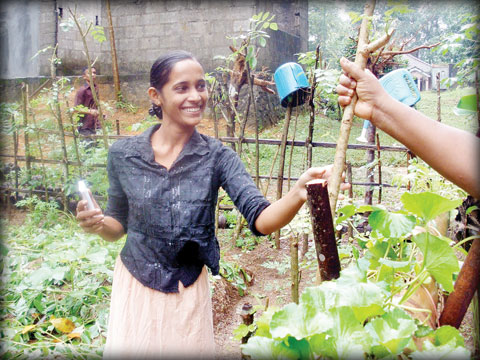Climate change challenges Lanka's home gardens
By Sohara Mehroze Shachi
Gamini Dissanayake has owned his vast home garden in Kandy, Sri Lanka
for many generations, paramparahs as he says. He proudly displays
freshly plucked nutmeg and betel leaf from his garden, and the towering
jackfruit tree that is the garden's centerpiece.
"From one tree we make an income of around twenty five thousand
rupees per year," he says. The January to March dry season leads to
fruiting in June-July. But in recent years there have been rains in
February, affecting the fruiting cycle.
"We can't fetch a good harvest," Dissanayake says, adding that he
knows from decades of experience that the climate is changing.
 There has been a slow and ambient rise of temperature in Sri Lanka,
0.01 - 0.03 degrees Celsius per year, which is reducing pollen
viability. Research conducted in the University of Peradeniya has shown
that there are more frequent occurrences of extreme weather events, with
increasing number of dry days, high intensity rains and tornado winds.
The wet areas are getting wetter and the dry areas drier, which are
having serious implications on food production. There has been a slow and ambient rise of temperature in Sri Lanka,
0.01 - 0.03 degrees Celsius per year, which is reducing pollen
viability. Research conducted in the University of Peradeniya has shown
that there are more frequent occurrences of extreme weather events, with
increasing number of dry days, high intensity rains and tornado winds.
The wet areas are getting wetter and the dry areas drier, which are
having serious implications on food production.
Kandy's case is representative of South Asian agriculture, which is
usually intensive with a large number of farmers growing a small amount
of produce each. A significant component of the smallholdings in the
region comprise of home garden systems - 14.3% of the total area of Sri
Lanka in 2014 comprised of home gardens and the figure is growing.
"Home garden is a very good land use system that helps balance the
landscape. Sustainability of the Kandyan home garden is mainly due to
the system structure - having perennials, the ecological functions and
the ability to fulfill the socio economic needs," says Dr Ranjith
Punyawardene from the Department of Agriculture of University of
Peradeniya.
South Asia's home gardens comprise of a complex sustainable land use
system with multiple farming components. It also involves bee keeping,
poultry and cattle farming, hydroponics and rainwater harvesting etc. It
effectively utilises limited spaces for crop production and ensures
systematic rainwater drainage. And according to United Nations Framework
Convention for Climate Change's (UNFCCC) findings, home gardening would
increase crop production in adverse climatic conditions.
The Asia Pacific Network on Global Change Research's (APN-GCR)
project titled "vulnerability of home garden systems to climate change
and its impacts on food security in South Asia" was implemented in one
site of Bangladesh, one in India and three sites of Sri Lanka to shed
more light on this issue. The changes in temperature and rainfall,
current status of the diversity in home gardens, socioeconomic
characteristics of home gardeners, and the extent to which climate
shocks have influenced the usage of adaptation strategies by the home
gardeners under changing climate were studied under this project.
"The conclusion of the project is that home gardens are climate
resilient. People are aware of climate change and they are adapting,"
said Professor Buddhi Marambe, director of the Agriculture Education
Unit of the University of Peradeniya.
Despite the evidence that climate change has taken place in the past
50 years, the composition of home gardens in Sri Lanka, India and
Bangladesh has not changed substantially. Home gardeners have already
adopted various strategies to adapt to climate change, such as
minimising soil erosion by conserving moisture when there isn't enough
rain through mulching, whereby coconut leaves are laid around tree
trunks. They have also applied techniques such as changing planting
dates, technology and use of new breeds.
"Strengthening and enhancing the Kandyan home garden systems in the
coming years so that it continues to provide quality ecological habitats
and other social and economic functions, and connects wild and other
cultivated habitats will be important for the future adaptation of this
globally important landscape and eco-friendly option of living," said
Gamini Pushpakumara, dean of the faculty of agriculture of University of
Peradeniya.
However, adaptation has its limits when there are drastic changes in
yield in the face of exacerbating impacts of climate change.
"It's going to be a warmer world," said Nalaka Gunawardene,
journalist trainer, media researcher and columnist, "the question is how
do we contain it from getting to the worst possible scenario." (Dhaka
Tribune)
|

